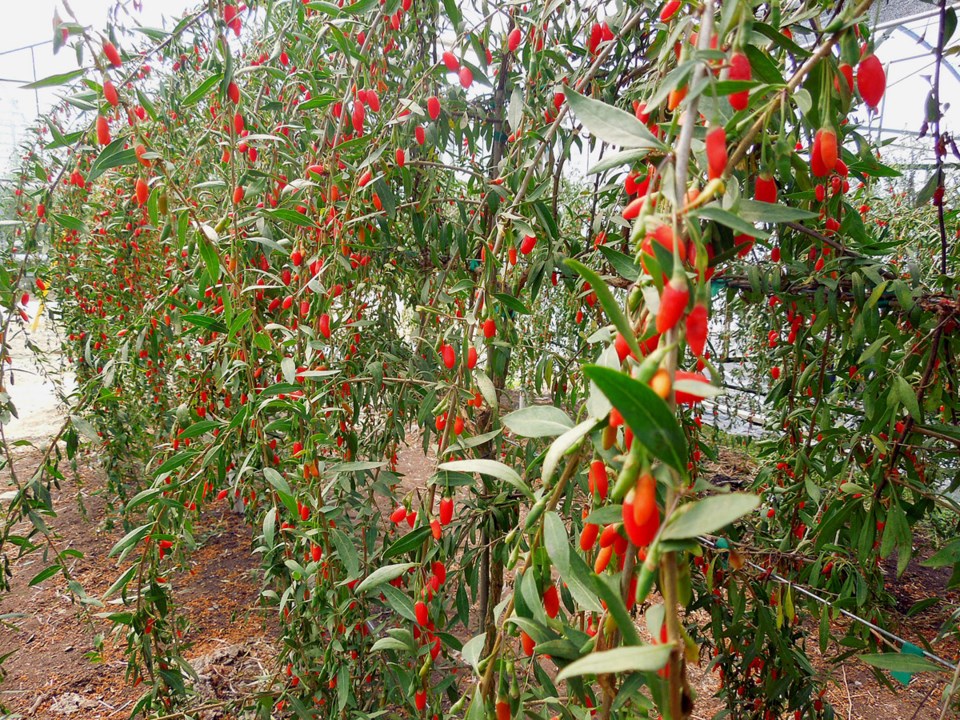Tire of turmeric? Bored of blueberries?
You’re in luck. There’s a new superfood in Vancouver and it’s called a goji berry.
Native to Asia, until now this so-called superfruit has typically only been available in Vancouver frozen, dried or powdered. But a determined farmer from Aldergrove is changing the way goji berries are grown and sold and at least while they’re in season, the dark orange fruit, considered to be chock-full of antioxidants, can be found fresh at a limited number of stores in Vancouver, including Whole Foods, Urban Fare and Choices Markets.
“Fresh gojis are extremely fragile,” said Peter Breederland. “You need to treat them like raspberries and eat them the day you buy them or the day after.”
During a tour of his Aldergrove farm this week, Breederland showed off row after row of the tiny reddish-orange fruit, which look similar to a jelly bean or tiny red pepper. And just as this province’s blueberry crops are ripening weeks early due to warm weather, many of Breederland’s goji berries are also ready for picking.
Breederland added the fresh berries are so delicate they must be picked by hand. Berries meant to be frozen or dried are picked by a machine with rubber fingers that shakes the fruit off the plant, which grows from a stalk. The goji is a member of the nightshade family, which also includes plants considered harmful when ingested. Not the case with gojis, often referred to as the “fountain of youth.”
The fact they’re hand-picked is one of the reasons fresh gojis are so expensive — a small plastic clamshell typically costs about $8.
“They are hand-picked at 8 a.m., usually picked up by 10 and the product is in the stores by 3 p.m., seven days a week,” said Breederland, who began selling the berries last year.
Breederland is one of very few farmers in North America making a go of growing goji berries commercially. He said some friends, family and fellow farmers were skeptical when he first announced his plans, but added that’s nothing new. It was that same determination that saw Breederland stop growing the large bell peppers he’d successfully harvested for years and begin successfully raising a smaller, super sweet version, which is sold in packages of three.
Breederland said the goji berry is known as the “happy berry,” which became the inspiration for the operation’s name, GoJoy, the brand under which they’re sold in stores. The berries are sweet with a slight tartness making them ideal for use in both savoury and sweet recipes, including ice cream and curries. GoJoy products are sold fresh, frozen or as a smoothie mix where the gojis are pureed with other berries considered high in antioxidants, such as blueberries, grown at nearby Lower Mainland farms.
Breederland said while he has no desire to compete with the Asian market, he is feeling pressure to begin exporting dried berries to China where he’s been told wealthy customers will pay what it takes to purchase a healthy, high-quality product.
“But I’m happy to be able to offer a fresh product locally,” he said. “That’s not being done.”
Breederland hopes to introduce a “you pick” program in 2016.
Visit gojoy.ca for more information about how goji fruit is grown locally.
Berry Mango Sorbet with Banana and Pineapple
A combination of frozen berries, mango and pineapple with frozen bananas to thicken it up and raw walnuts for a touch of buttery richness. The result is somewhere between banana ice cream and sorbet.
Ingredients:
- 1/4 cup walnuts
- 1 cup water
- 1 cup frozen mango
- 2 frozen bananas
- 3/4 cup pineapple
- 3/4 cup fresh or frozen goji berries
Method:
- Blend the walnuts together with the water until smooth.
- Add the rest of the ingredients and blend until smooth and thick
@sthomas10



